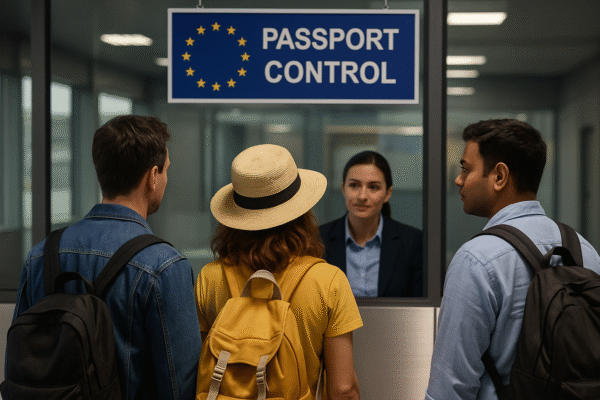Brussels, Belgium – July 24, 2025 – International travelers from visa-free countries, including the United States, United Kingdom, Canada, India, Australia, Japan, and Brazil, will face a major change when planning trips to Europe from late 2026. The European Union is raising the fee for the European Travel Information and Authorisation System (ETIAS) from the current €7 to €20 per traveler, marking a nearly 185% increase aimed at bolstering regional security.
This upcoming change will apply to all travelers entering the Schengen Area and associated European countries under visa-exempt status. As the ETIAS system moves toward full implementation in the fourth quarter of 2026, travelers should begin preparing now for this key shift in Europe’s entry requirements.
Why the ETIAS Fee Is Increasing
According to the European Commission, the revised €20 ETIAS fee is intended to finance enhanced border protection infrastructure, improve interoperability with Europol and Interpol databases, and support the long-term sustainability of the digital authorization system. The EU emphasized that the price hike brings the ETIAS system in line with similar international models such as the U.S. ESTA ($21) and the UK’s ETA (£10).
Funds from the increased fee will be reinvested into:
- Strengthening EU external border security
- Real-time criminal and security background checks
- Streamlining traveler screening and reducing wait times
- Enhancing data protection and interoperability between agencies
“The goal is to make Europe safer while ensuring a smooth entry experience for millions of tourists,” said an EU Home Affairs spokesperson.
Who Will Be Affected by the New €20 Fee?
The fee increase will impact nationals from approximately 60 visa-exempt countries who currently do not need a visa to enter the Schengen Area for short stays. This includes major outbound tourism markets:
- United States
- United Kingdom
- Canada
- India (applicable to those with long-term residency in visa-exempt nations)
- Australia
- Japan
- Brazil
- South Korea, Mexico, New Zealand, Singapore, and more
Whether traveling for tourism, business, or transit, eligible travelers from these countries will be required to obtain an ETIAS authorization and pay the updated €20 fee before entering Europe.
Where ETIAS Will Be Required
ETIAS will be mandatory for entry into 30 European countries, including all Schengen Zone members and select EU states. These countries include:
- Popular destinations: France, Italy, Spain, Germany, Greece, Netherlands, Portugal
- Central and Eastern Europe: Czech Republic, Hungary, Poland, Slovakia, Slovenia
- Nordic countries: Denmark, Sweden, Finland, Norway, Iceland
- Others: Switzerland, Austria, Belgium, Croatia, Luxembourg
- Future additions: Bulgaria, Romania, and Cyprus are expected to adopt ETIAS requirements upon full Schengen accession.
Together, these nations represent Europe’s most-visited tourist hotspots, hosting over 500 million international arrivals annually.
Exemptions from the ETIAS Fee
Despite the fee increase, several groups will continue to be exempt from paying the ETIAS charge:
- Children under 18
- Seniors over 70
- Relatives of EU citizens traveling with supporting documentation
These travelers will still be required to submit an ETIAS application but will not incur a fee.
How the ETIAS System Works
ETIAS is not a visa, but a pre-travel security clearance system for short-term stays up to 90 days within a 180-day period. Once approved, the authorization is:
- Valid for three years or until passport expiry
- Usable for multiple entries across all ETIAS-participating countries
- Linked electronically to the applicant’s passport
The application process is expected to take only 10 minutes online, and most applicants will receive approval within minutes. However, travelers with red flags may face extended review.
What Travelers Should Do Now
With the system set to go live in late 2026, travelers from the U.S., UK, Canada, and other affected countries should begin preparing by:
- Staying updated via the EU’s official ETIAS portal (https://travel-europe.europa.eu/etias_en)
- Monitoring for final parliamentary approvals and launch announcements
- Factoring in the €20 fee into future travel budgeting
- Ensuring passports have at least three months of validity beyond planned departure from Europe
Those planning multi-year trips or frequent European travel after 2026 may want to apply early once the system opens to lock in the three-year validity and simplify re-entry.
Global Reaction and Comparison
While some travel advocates have expressed concerns about rising costs, others point out that the ETIAS remains less expensive than traditional visa applications, which can cost upwards of €60–€100. Compared with:
- ESTA (USA): $21
- ETA (UK): £10
- eTA (Canada): CAD $7
The ETIAS fee remains competitive within global travel authorization systems.
Conclusion
As Europe modernizes its borders with ETIAS, travelers from visa-free countries must prepare for a new era of pre-authorized entry. Though the fee increase from €7 to €20 may add a cost, the validity period, ease of application, and enhanced travel security offer benefits for both visitors and host nations.
For millions eyeing European holidays in 2027 and beyond, now is the time to stay informed, budget accordingly, and be ready to apply once the system launches.
For more travel news like this, keep reading Global Travel Wire






















